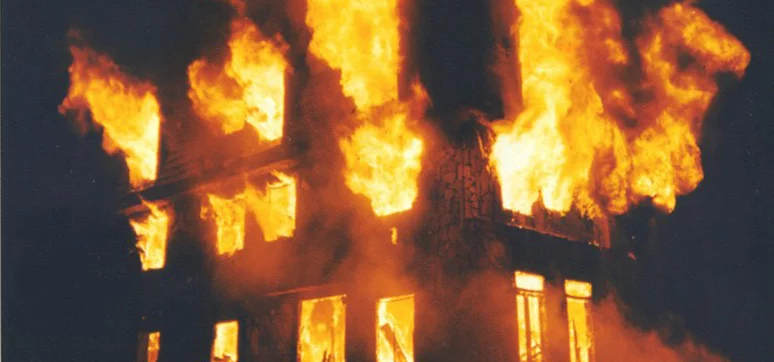Façade designs and materials have been improvised in the past years to meet the fire safety regulations in the Middle East. The façade materials should be appropriately tested and fire stopping is also very important to ensure the safety of the buildings. Specifying the correct product is vital but the quality of the installation of the product is vital too for ensuring fire protection. The safety of life is a vital aspect that should be considered during the design and material selection section of buildings. A fire-safe façade does not propagate fire but it also prevents or not allows the fire and heat to travel from one area to another. This cover story focusing on the major reasons behind fires in buildings in the Middle East, the façade material selection and design approach for a fire-safe building, the importance of compartmentation and fire stop, etc.
Façade Design And Fire Safety Of Buildings – Impacts

Over the past decade, the desire for taller buildings has increased dramatically around the world, particularly in the GCC region where the real estate developers compete to recognise their buildings among the tallest, if not the world’s tallest. This was the reason why local fire authorities have been regularly revising the applicable fire codes, in order to enforce stricter requirements related to the design, manufacture, and installation of façade systems, says Dr. Ayoub Nasr, Principal Engineer, Ramboll.
When combustible materials are used for façade cladding and/or insulation, there is undoubtedly a risk that a fire can spread rapidly from floor to floor if it comes into contact with these materials. This would delay or completely rule out the possibilities for a safe evacuation, which could lead to death, injury, and loss of business confidence.

Therefore, increasing the level of understanding of the mechanisms governing the vertical spread of fire across façades as well as the acceptable testing methods and fire-stopping solutions is nowadays a key task for all fire experts, façade engineers, and contractors in order to achieve the required authority approvals, but most importantly to achieve a safe and operationally efficient building. As a result, the risk of vertical spread of fire around the building façade should never be underestimated!
Abdullah Faza, Senior Fire and Life Safety Consultant, AESG believes that there are three main fire safety aspects that should be considered at the various stages of the façade design:
Fire rating requirement on the façade and the exterior wall systems: This aspect should be determined at the early design stage (concept) which will rely on the separation distance to the adjacent building or plot limit. Table 1.3 on page 59 of UAE Fire & Life Safety Code, 2018 defines the fire rating requirements of exterior walls based on horizontal separations.
In most of the cases (based on the occupancy type) 6m separation distance and more to the adjacent building will not require fire-rated exterior walls. This aspect will have a direct impact on façade and exterior cladding materials, whether noncombustible or fire-rated materials are required.
Location of fire-stopping systems at the façade and exterior wall systems: This exercise should be carried out during the Concept and Schematic design stages to identify the required locations of:
- Horizontal fire barriers: Following the requirements of the UAE Fire & Life Safety Code, 2018, Section 4.5.4.1, page 142, cavity fire barriers shall be incorporated horizontally on every floor.
- Vertical fire barriers: Following the requirements of the UAE Fire & Life Safety Code, 2018, Section 4.5.4.2, page 142, cavity fire barriers shall be incorporated on every floor vertically to restrict flame within continuous cavities or where cavities bridge the perimeter fire-stopping.
- Perimeter fire barrier: Following the requirements of the UAE Fire & Life Safety Code, 2018, Section 3.2.4, page 128 The perimeter barrier shall be intended to restrict the interior vertical passage of flame and hot gases from one floor to another at the location where the floor intersects the inside of an exterior curtain wall.
However, the above three applications might not be the case in all façade designs. In general, the location of fire barriers shall consider the location and quantity of openings at the exterior wall systems, mechanism of fire spread, ignition sources, cavity size, different exterior wall types, and combustibility of the exterior wall materials. The professional Fire Consultant should have sufficient knowledge of façade and exterior wall design and materials, which will help him/her to carry out flame and smoke risk assessment to identify the location of fire barrier systems. The risk assessment should consider all the possible fire scenarios “in and within” the façade and exterior wall systems.
Fire characteristics of the façade and exterior wall materials: This exercise can be carried out in advanced or final design stages to determine the following key material’s characteristics from a fire safety perspective:
- Fire rating: Duration for which a passive fire protection system can withstand a standard fire-resistant test. Testing example: AEST E119
- Combustibility: How fast material will burn, typically classified in Class A, B, C, D, E, F. Testing example: EN 13501-1
- Flame / Smoke spread index: Measurement of surface flame spread and smoke density. Testing example: ASTM E84
- Self-Ignition Temperature: The value of the lowest ambient air temperature that will cause the ignition of the material (flash ignition temperature). Testing example: ASTM D1929
- Fire propagation: Determine the fire propagation characteristics of exterior wall assemblies and panels. Testing example: NFPA 285 / BS 8414 or similar large-scale test.

Abhishek Chhabra, Business Development Manager, Thomas Bell-Wright International Consultants says, façade designing is the key starting point of ensuring fire safety. Incorrect comprehension of reaction to fire properties can lead to accidents ready to happen! Further and equally critical is to ensure correct materials reach the site using certification and listing. Validated designs are installed correctly using qualified inspectors.
Role Of The Fenestration Design In Firesafe Buildings
Faza explains windows and doors at the façade and exterior wall elevations form a key means of flame, heat, and smoke spread from the building to the exterior walls and cavities. In many cases, they will have a direct interface with cavities (air gaps) behind the exterior wall panels (window for example) and the exterior surface of the panels (balcony for example). This direct interface can lead to a rapid-fire spread from the building interior to the exterior wall systems, just like what happened with Grenfell Tower in London.
Cavity fire barriers are the most efficient control measure to minimise the risk of flame, heat, and smoke spread at fenestration (exterior wall openings). They shall be located around the openings to restrict any spread of flame, heat, and smoke from an apartment fire, for example to the air cavity which will avoid fire spread from one apartment to another. The location of those barriers shall consider the air gap size, the design interface between openings and exterior walls, and the internal building compartmentation (separation between apartments for example). I highly recommend the need to adopt a party wall separation design approach of Approved Document B (British Standard).
Common Cause For Building Fires In The Middle East

With almost every international and local fire code nowadays requiring adjacent buildings to be located at a sufficient distance from each other, a large building fire is likely to occur when a fire breaks out within the building itself, either from the inside of the building or from the outside immediately next to the external wall cladding, notes Dr Nasr. In both cases, the installation of combustible façade materials consists of the main cause for a fire to spread over multiple floors, thereby increasing its severity while reducing the response and egress time for higher floors of the building.
Other factors include human errors that cause active and passive fire protection systems to fail during fire emergencies, from simple but serious actions like switching off the fire protection systems to more complex errors such as adopting faulty engineering practices during design development, installing cheap but incompatible systems, or disregarding the regular testing and maintenance works which are required to sustain the long-term functionality of these systems.
I believe that avoiding a large fire from occurring in a building is a long journey starting at the early design stage through adopting the correct engineering practices, that continues during construction through achieving a proper installation of the tested and listed façade and fire-stopping systems, to finally ensure the regular inspection and maintenance works are well managed by the facility manager after the building is occupied.

Faza says the causes of building fires in the Middle East vary from one occupancy to another. However, by focusing on façade fires in the Middle East, aluminium composite panels have the highest record of causing rapid fire spread at the building exterior due to the combustible and flammable used cores (especially for buildings designed before 2013). The lack of fire safety design requirements at that time (before 2013) created a knowledge gap of how to design a safe façade and exterior wall cladding systems.
Nowadays, Fire and life safety codes have been updated with specific sections about how to design the building’s façade and exterior walls to be safe. He adds, “I highly encourage designers and engineers to consult the right fire engineers/consultants in helping them achieve the functional requirements of the code and not only comply with the code requirements because it might not be sufficient but to go above and beyond in the measures taken to make buildings safe”.
According to Chhabra, the common causes for fire accidents in the buildings are: designs using incorrect materials, lack of validation of designs using large-scale mock-up tests, missing out and not using certification and listing evidence to inspect that certified materials have reached the site or some other, and use un-qualified inspectors to validate the installation.
Scenarios To Cause An Internal Building Fire To Spread To The External Façade And Other Parts Of The Building
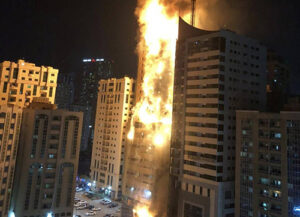
Despite the fact that all new high-rise buildings are equipped (or must be) with an automatic sprinkler system with proper fire compartmentation should be maintained throughout the building spaces and between adjacent floors, an internal building fire can still occur which has the potential to spread to the external façade, remarks Dr. Nasr.
A ventilation-controlled fire represents the scenario in which a fire burning in a room grows enough to break the window glazing, permitting hot gases to flow out the top portion of the opening. After the temperature of the fire has increased enough and the exterior façade is exposed to sufficient heat fluxes, the window of the story above the room of origin could fail, resulting in the spread of the fire to the upper floor. This is what is usually referred to in fire engineering books as the “leap-frog effect”.
From a fire dynamic perspective, flames emitting from an exterior window can extend higher than 5 m above the top of the window. He adds, that to prevent a leap-frog effect from occurring, a good practice that has been largely adopted lately in the Middle East is to separate the exterior openings in adjacent floors by using insulated spandrel panels of 915 mm in thickness or similar assemblies that have a fire-resistance rating of at least 1-hour. Alternatively, flame barriers that extend horizontally at least 760 mm beyond the exterior wall can also be proposed to restrict the vertical fire spread through the façade. Let’s not forget to mention other protection means such as installing window sprinklers on the inside of an exterior window which could also limit the spread of fire from inside the building to the outside.

The lack of passive and active control measures might lead to internal fire spreading to the external façade. Some of the passive fire protection failures can be related to the absence, poor, or damage of fire-stopping/cavity barrier systems at the external wall systems along with the provision of combustible/flammable materials such as insulation, membranes, sealants, baker rods, etc. On the other hand, the provision of a sprinkler system as an active fire protection measure will minimise the fire spread risk by extinguishing the fire (inside the building) at a very early stage and controlling the temperature at a certain level (low temperature), says Faza.
A compliance design approach with Fire & Life Safety Code requirements can be considered as an adequate protection measure. However, a risk assessment, design approach is highly recommended when it comes to façade and exterior wall design. It will identify any hazard and risk within the façade and exterior walls, which will provide a clearer path to the fire engineer/consultant in proposing passive measures, active measures, or a combination of both, he adds.
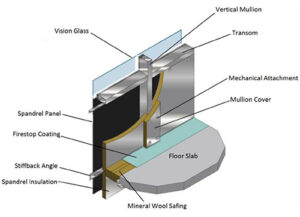
Difference Between Fire Stops And Smoke Stops
Both fires stops and smoke stop systems are used to fill the continuous gap at the interface junction between the façade and concrete slab edge. These systems aim to keep fire, smoke, and noxious gases to a restricted area/ floor by dividing a building into fire-resisting compartments. Hence, these systems play a crucial role in minimising fire damage and limiting casualties, opines Dr. Nasr.
Fire stops usually consist of fire-rated compressed insulation materials, such as mineral wool insulation, having a thickness of a minimum of 100 mm. The fire stop shall be a minimum of 33% greater than the gap width and compressed into place (reference: Hilti installation guide). Smoke stops consist of water-based coatings/ sprays with smoke-sealing property which is applied on top of fire stop insulation to prevent the passage of smoke between fire compartments. The thickness of smoke, stop sealants usually varies between 1-3 mm. The smoke seal should have the flexibility to allow all anticipated movements in the wall system and should remain intact.
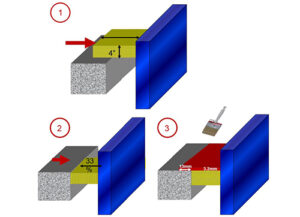
How Important Is The Use Of Fire-Rated Glass?
The glass itself does not support combustion, hence it is very common to see standard non-fire-rated glass panels and windows installed at building envelopes in the Middle East. This practice should be acceptable as long as the building can maintain a minimum horizontal separation from the adjacent buildings and the plotline, says Dr Nasr. On the other hand, and despite the high cost associated with the use of fire-rated glass, architects tend to propose fire-rated glazing systems for interior design applications, such as to achieve the required fire separation between different occupancy groups, enclose lift and escalator lobbies, etc.
The advantage of using a fire-rated glazing system is that it allows to maintain a sense of transparency and openness throughout the building, and at the same time to satisfy the authority requirements for fire compartmentation. Faza explains that the fire stops are a continuous barrier/membrane with a minimum of a 1-hour fire rating that subdivides the building spaces to restrict the spread and movement of fire.
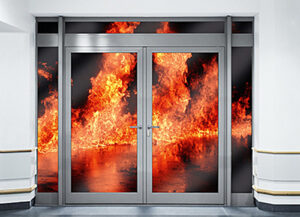
Smoke stops are a continuous barrier/membrane that subdivides the building spaces to restrict the spread and movement of smoke. It can be noticed that the key difference between them is that fire stops are fire-rated membranes, but smoke stops are not, which qualifies fire stops to work as smoke stops as well as its main purpose of fire stopping.
NFPA 5000 requires smoke and fire barriers to be continuous from an outside wall to an outside wall, from a floor to a floor, or from a smoke/fire barrier to a smoke/fire barrier, or a combination thereof. It also requires them to be continuous through all concealed spaces, such as those found above a ceiling, including interstitial spaces.
The provision of competent passive fire protection measures represented by fire-stopping systems will help prevent a fire from spreading in buildings. Fire-stopping provisions should cover all the firestop classifications following UAE Fire & Life Safety Code, 2018, Section 3, page 126:
Through-penetration firestop system:
- Penetrations through the fire-resistance rated floor, including both empty openings and openings containing penetrants.
- Penetrations through fire-resistancerated wall assemblies including both empty openings and openings containing penetrants.
- The penetrants include, but are not limited to, mechanical, electrical, piping, structural, and communication devices.
- Testing examples: ASTM E 814, UL 1479, EN 1366-3, FM 4990
Membrane-penetration firestop system:
- Membrane penetrations in fire-resistance rated wall assemblies where items penetrate one side of the barrier.
- Testing examples: ASTM E119, E 814, UL 263, UL 1479, BS EN 1366-3, BS EN 1366- 4, FM 4990.
Fire resistive joint systems:
- Any gap, joint, or opening (whether static or dynamic) between two fire-rated barriers, including where the top of a wall meets a floor, wall edge to wall edge configurations, floor edge to floor edge configurations, floor edge to wall configurations.
- Testing examples: ASTM E1966, UL 2079, FM 4990, BS EN 1366-4.
Perimeter fire barrier system:
- Any gap, joint, or opening, whether static or dynamic, between a fire-rated floor assembly and a non-rated exterior wall assembly.
- The perimeter barrier shall be intended to restrict the interior vertical passage of flame and hot gases from one floor to another at the location where the floor intersects the inside of an exterior curtain wall.
- Testing examples: ASTME 2307, BS EN 1364-3, BS EN 1364-4
It has to be noted that all of the above should be tested and certified by approved laboratories and certification bodies, designed by certified fire engineers, installed by approved fire-stopping installed and finally certified and inspected by fire-stopping specialists.
Abdullah Faza, Senior Fire and Life Safety Consultant, AESG
Prevention Of Fire Spread In Buildings

According to Dr. Nasr, there are some basic steps to take that will help to ensure fire protection in buildings:
- Avoid façade materials that belong to the flammable class.
- Maintain a minimum height, and distance between windows on exterior walls in order to prevent the possibility of a fire spreading from one floor to another
- Cavity fire barriers shall be incorporated into the façade design on every floor, horizontally and vertically
- Protecting the building perimeter also requires the extension of the fire-rated floor to the exterior wall surface; apply fire/smoke stop systems where necessary to fill the gap between the façade and concrete slab edge
- Ensure regular inspection and maintenance of perimeter fire barriers and fire protection systems
- Increase fire safety awareness among the building occupants and enforce certain FM rules such as restricting cooking and BBQ activities in balconies etc.
Significance Of Compartmentalization In Structure

Faza believes that the main purpose of fire separation/compartmentation is to restrict the spread of flame, heat, and smoke from one area to another. The restriction will provide a certain insulation and integrity period depending on the building’s Fire and Life Safety Strategy (1 hour, 2 hours, etc.). The provision of such fire spread measures will enhance the protection of building structural elements such as beams, columns, bearings, floors, etc., by keeping them away from direct exposure to flame and heat. This will eventually buy more time for the building to reach the catastrophic fire stage, which can be demonstrated by longer Available Safe Egress Time (AEST). It is very important to understand the relationship between Available Safe Egress Time (AEST) and Required Safe Egress Time (REST) in adopting a performance-based design approach.
CONCLUSION
Fire-safe buildings are gaining more popularity and have changed the scenario of the building and real estate industry around the world. Several façade materials that ensure fire protection in buildings have become the most demanding materials of today’s time. Improved designing and installation methods have been introduced in order to ensure fire-safe buildings or to prevent the fire spread if the building catches fire.
